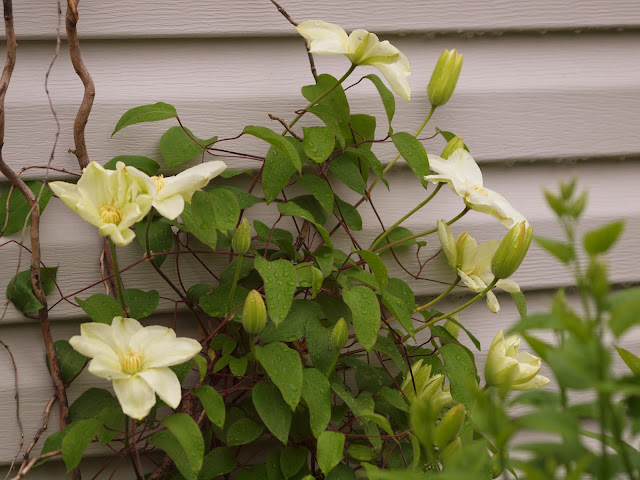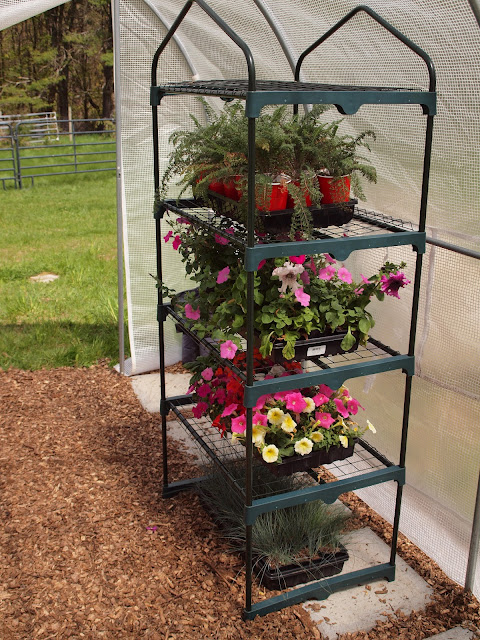I'm obsessed. The tulip I couldn't remember is Mango Charm, purchased from Johnny's Selected Seeds. It should be called Chameleon, because it is constantly changing.
It starts out with a yellow-green bud.
As it opens, the petals become a soft yellow tinged with apricot, perfectly complimenting the Apricot Whirl and Pink Charm narcissus (also purchased from Johnny's).
It slowly becomes more pink, almost mimicking a soft sunset.
And finally, it ends its reign by turning a beautiful blush pink tinged with white.
Most tulips don't reliably rebloom season after season, so I'll be sure to purchase more of these to plant this autumn. They're just breathtaking.
Also breathtaking is a clematis that I purchased, in of all places, Ocean State Job Lots. I purchased three clematis a few years ago, and the packaging gave no indication as to the actual variety or type of clematis it was. I just assumed it was from the summer blooming group, or Group 3. This group produces flowers on new wood, or new growth, so every spring I would cut them to the ground and allow them to regrow, but never saw much for flowers. In fact, the only flowers I would get were the Nelly Moser-type pink with white edges. Disappointing, as I already had one of those. This spring I didn't get around to cutting them down quick enough, and suddenly there were blossoms swelling all over the plants. I decided to let them be and see what happened. I'm so glad I did!
It seems this particular clematis is from Group 1, or the spring blooming group, which flowers on old wood. If I'm lucky, it may end up being a group 2, which is a reblooming variety. These will bloom on old and new wood, so I'm doubtful that's the case, otherwise I would have seen these gorgeous creamy blooms over the last two years.
I did finally get the cover on the polytunnel, and my seedling plants have been moved out of the house and into that for hardening off. I ended up using some bark chippings my mother had to create a grass-free base. I love that the wood chips retain moisture so that when I close the polytunnel up, it creates a lovely humid environment for the plants.
They're all responding well except for the baptisia seedlings, which have begun a mass die-off. This coming week is supposed to shoot up to summer like temperatures, so I'll plant them out and see how they do.
I've got a decent start on the new section of mule track, too. I am waiting for some gate hardware to arrive before I put up the welded wire fence, but I think this is going to work out well.
I've been using Reputa to haul manure out to the back of the pasture, and she's been working great. It's so good to have her back to work! Li'l Red has been down and out since autumn with rust chips clogging the gas line and a massive mouse nest in the motor. Luckily my ex's cousin is a mobile tractor repair person, and he was able to flush the gas tank so it looks brand new, repair the gas cap to prevent water from getting in, and peel out the mouse nest. I fired it up and one more mouse ran out of the motor and hit the ground running, and a minute later another one was belly up inside the cover but fell back into the motor when I shut it off. I think there might be an endless supply of mice living in my tractor motor, and it freaks me out. My plan is to start it up and walk away, allowing it to run and hopefully drive out the furry invaders.
I've finished another section of the dead hedge, and I'm learning as I go. This section was made up of mostly forsythia trimmings, and I'm not sure how the mixed material is sitting with me.
I don't mind if there's mixed material in each panel, but having one panel mostly brush with not many thicker branches looks a little funky. Again, the advantage of this hedge is that it will always be changing depending upon the materials available. I'm ok with that, because it's FREE. The corner was a little tricky, and I have to angle the next section to run parallel with the barn. Once I start running a fairly straight line, I think it's going to go up fast. At least I hope so; I'm still running behind!































